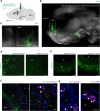A hypothalamic dopamine locus for psychostimulant-induced hyperlocomotion in mice
- PMID: 36209152
- PMCID: PMC9547883
- DOI: 10.1038/s41467-022-33584-3
A hypothalamic dopamine locus for psychostimulant-induced hyperlocomotion in mice
Abstract
The lateral septum (LS) has been implicated in the regulation of locomotion. Nevertheless, the neurons synchronizing LS activity with the brain's clock in the suprachiasmatic nucleus (SCN) remain unknown. By interrogating the molecular, anatomical and physiological heterogeneity of dopamine neurons of the periventricular nucleus (PeVN; A14 catecholaminergic group), we find that Th+/Dat1+ cells from its anterior subdivision innervate the LS in mice. These dopamine neurons receive dense neuropeptidergic innervation from the SCN. Reciprocal viral tracing in combination with optogenetic stimulation ex vivo identified somatostatin-containing neurons in the LS as preferred synaptic targets of extrahypothalamic A14 efferents. In vivo chemogenetic manipulation of anterior A14 neurons impacted locomotion. Moreover, chemogenetic inhibition of dopamine output from the anterior PeVN normalized amphetamine-induced hyperlocomotion, particularly during sedentary periods. Cumulatively, our findings identify a hypothalamic locus for the diurnal control of locomotion and pinpoint a midbrain-independent cellular target of psychostimulants.
© 2022. The Author(s).
Conflict of interest statement
The authors declare no competing interests.
Figures







Similar articles
-
Suprachiasmatic efferents avoid phenestrated capillaries but innervate neuroendocrine cells, including those producing dopamine.Endocrinology. 1997 Mar;138(3):1312-20. doi: 10.1210/endo.138.3.4976. Endocrinology. 1997. PMID: 9048641
-
Presence of somatostatin or neurotensin in lateral septal dopaminergic axon terminals of distinct hypothalamic and midbrain origins: convergence on the somatospiny neurons.Exp Brain Res. 1993;92(3):420-30. doi: 10.1007/BF00229030. Exp Brain Res. 1993. PMID: 7681010
-
Suprachiasmatic nucleus-dependent and independent outputs driving rhythmic activity in hypothalamic and thalamic neurons.BMC Biol. 2020 Sep 30;18(1):134. doi: 10.1186/s12915-020-00871-8. BMC Biol. 2020. PMID: 32998726 Free PMC article.
-
Restoration of circadian behavior by anterior hypothalamic grafts containing the suprachiasmatic nucleus: graft/host interconnections.Chronobiol Int. 1998 Sep;15(5):513-33. doi: 10.3109/07420529808998705. Chronobiol Int. 1998. PMID: 9787939 Review.
-
Circadian insights into dopamine mechanisms.Neuroscience. 2014 Dec 12;282:230-42. doi: 10.1016/j.neuroscience.2014.07.081. Epub 2014 Oct 2. Neuroscience. 2014. PMID: 25281877 Review.
Cited by
-
Role of vesicular monoamine transporter-2 for treating attention deficit hyperactivity disorder: a review.Psychopharmacology (Berl). 2024 Nov;241(11):2191-2203. doi: 10.1007/s00213-024-06686-7. Epub 2024 Sep 20. Psychopharmacology (Berl). 2024. PMID: 39302436 Review.
-
Innervation density governs crosstalk of GPCR-based norepinephrine and dopamine sensors.bioRxiv [Preprint]. 2024 Nov 23:2024.11.23.624963. doi: 10.1101/2024.11.23.624963. bioRxiv. 2024. PMID: 39605389 Free PMC article. Preprint.
-
The Dopaminergic System Modulates the Electrophysiological Activity of the Suprachiasmatic Nucleus Dependent on the Circadian Cycle.Neurochem Res. 2023 Nov;48(11):3420-3429. doi: 10.1007/s11064-023-03988-8. Epub 2023 Jul 14. Neurochem Res. 2023. PMID: 37452257
-
Involvement of posterior hypothalamic CaMKII-positive neurons in ADHD-like behaviors in mice.Mol Brain. 2024 Aug 5;17(1):51. doi: 10.1186/s13041-024-01122-5. Mol Brain. 2024. PMID: 39103932 Free PMC article.
-
Brain-wide mapping of efferent projections of glutamatergic (Onecut3+ ) neurons in the lateral mouse hypothalamus.Acta Physiol (Oxf). 2023 Jul;238(3):e13973. doi: 10.1111/apha.13973. Epub 2023 Apr 25. Acta Physiol (Oxf). 2023. PMID: 37029761 Free PMC article.
References
Publication types
MeSH terms
Substances
LinkOut - more resources
Full Text Sources
Molecular Biology Databases

